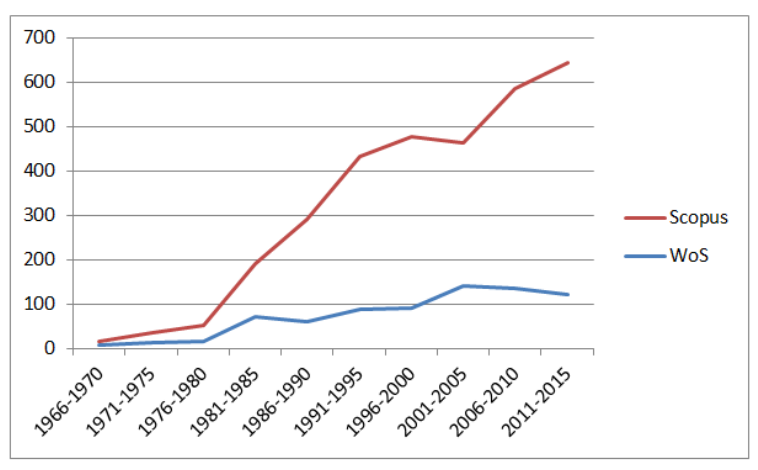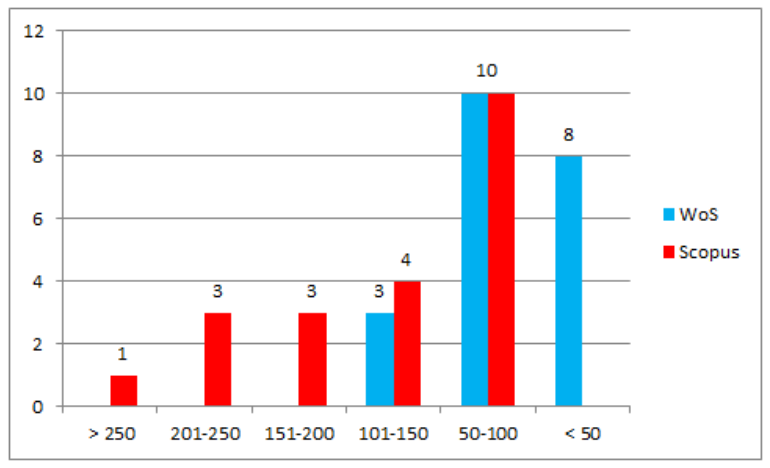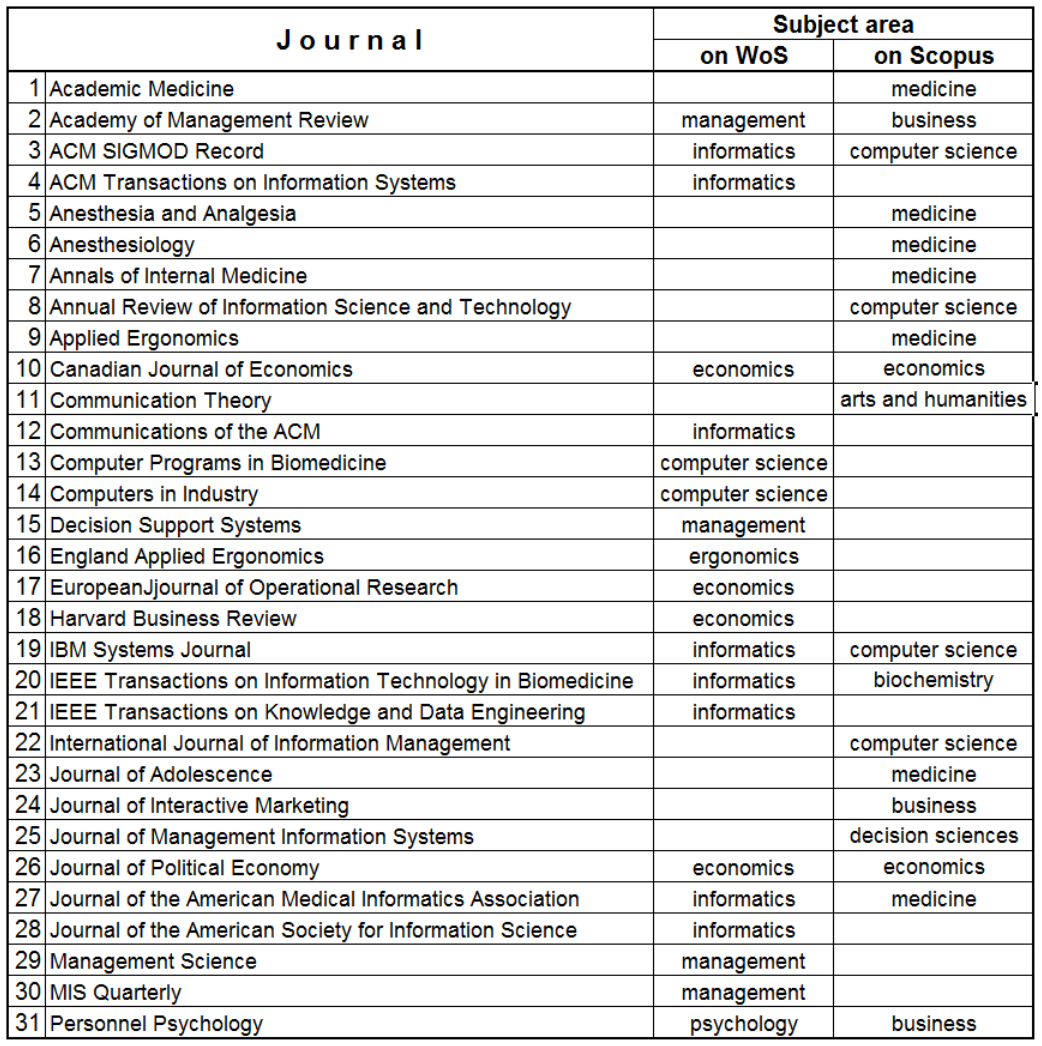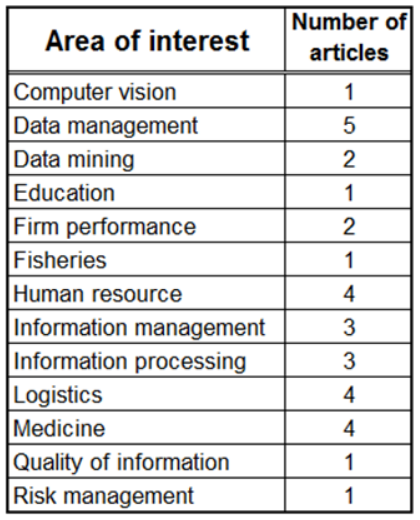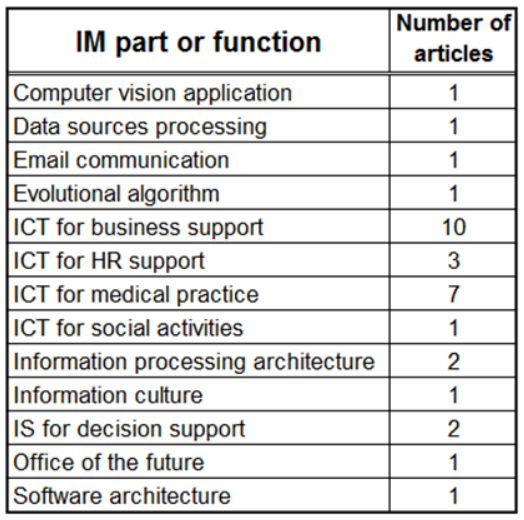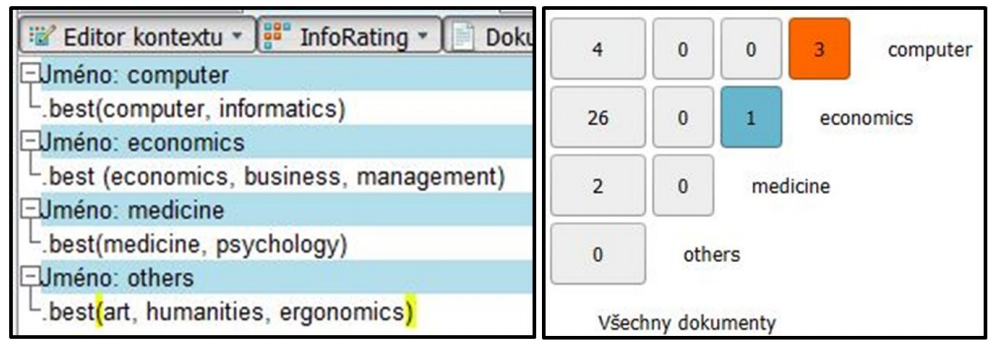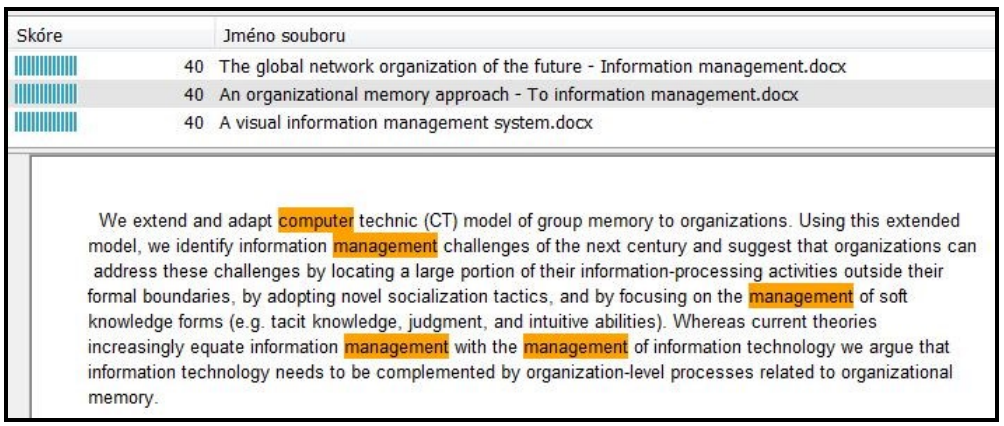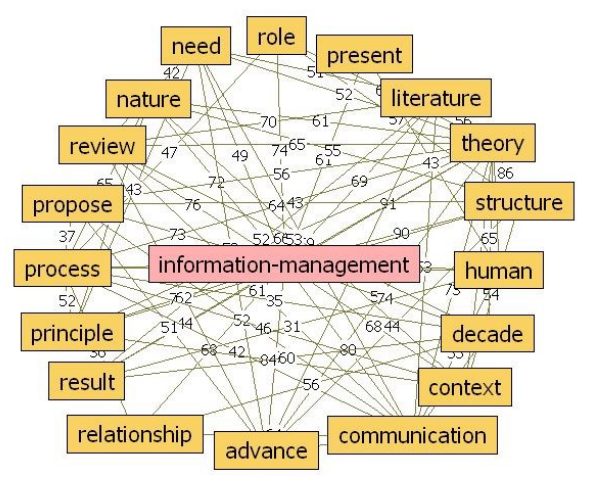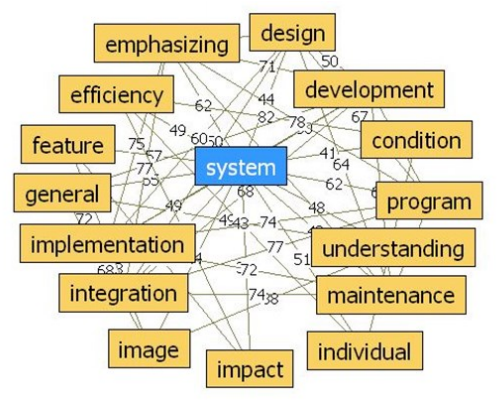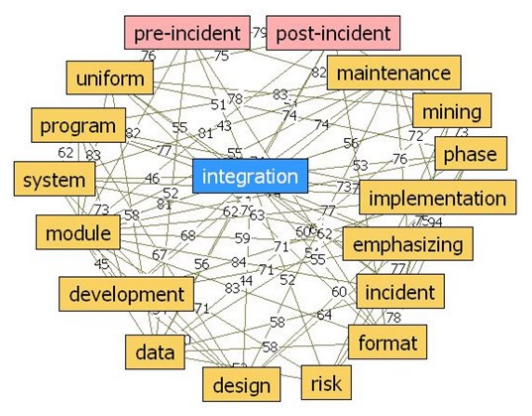Difference between revisions of "Journal:Information management in context of scientific disciplines"
Shawndouglas (talk | contribs) (Saving and adding more.) |
Shawndouglas (talk | contribs) (Saving and adding more.) |
||
| Line 5: | Line 5: | ||
|caption = | |caption = | ||
|title_full = Information management in context of scientific disciplines | |title_full = Information management in context of scientific disciplines | ||
|journal = ''Journal of Systems | |journal = ''Journal of Systems Integration'' | ||
|authors = Buřita, Ladislav | |authors = Buřita, Ladislav | ||
|affiliations = University of Defense in Brno | |affiliations = University of Defense in Brno | ||
| Line 15: | Line 15: | ||
|doi = [http://10.20470/jsi.v9i1.314 10.20470/jsi.v9i1.314] | |doi = [http://10.20470/jsi.v9i1.314 10.20470/jsi.v9i1.314] | ||
|issn = 1804-2724 | |issn = 1804-2724 | ||
|license = [https://creativecommons.org/licenses/by-nc/3.0/cz/deed.en Creative Commons Attribution-NonCommercial 3.0 Czech Republic ] | |license = [https://creativecommons.org/licenses/by-nc/3.0/cz/deed.en Creative Commons Attribution-NonCommercial 3.0 Czech Republic] | ||
|website = [http://www.si-journal.org/index.php/JSI/article/view/314 http://www.si-journal.org/index.php/JSI/article/view/314] | |website = [http://www.si-journal.org/index.php/JSI/article/view/314 http://www.si-journal.org/index.php/JSI/article/view/314] | ||
|download = [http://www.si-journal.org/index.php/JSI/article/view/314/328 http://www.si-journal.org/index.php/JSI/article/view/314/328] (PDF) | |download = [http://www.si-journal.org/index.php/JSI/article/view/314/328 http://www.si-journal.org/index.php/JSI/article/view/314/328] (PDF) | ||
| Line 56: | Line 56: | ||
<blockquote>Information management is shown ... as activities focused on managing of all information assets used by an enterprise. Management plays a leading role in the guiding and enforcement of innovation; on the other side, thanks to innovation within ICT, some activities in information management are performed by machine, creating additional spaces for management's own creativity (and further innovations). Information management is also important for maintaining close contact between ICT manufacturers and their customers on the part of the enterprises. Successful implementation of innovations is not possible unless ICT manufacturers are well acquainted with their customers and theirs needs as well as their changing demands on technology.</blockquote> | <blockquote>Information management is shown ... as activities focused on managing of all information assets used by an enterprise. Management plays a leading role in the guiding and enforcement of innovation; on the other side, thanks to innovation within ICT, some activities in information management are performed by machine, creating additional spaces for management's own creativity (and further innovations). Information management is also important for maintaining close contact between ICT manufacturers and their customers on the part of the enterprises. Successful implementation of innovations is not possible unless ICT manufacturers are well acquainted with their customers and theirs needs as well as their changing demands on technology.</blockquote> | ||
==Methodology of Research and the Statistical Results== | |||
The research methodology first involved the selection of publications, indexed on WoS and Scopus. The selection criterion was the phrase "information management" in the title of the publication, only journal articles, issued up to the year 2015. The results of the selection were arranged according to the publication year, in five-year intervals, with a total of 741 articles on WoS and 2450 on Scopus; see Fig. 1. The trend in the number of publications is linear on both servers, but on Scopus the growth is steeper. The next step of the research was statistical analysis of the selected papers. | |||
[[File:Fig1 BuřitaJOfSysInteg2018 9-1.png|600px]] | |||
{{clear}} | |||
{| | |||
| STYLE="vertical-align:top;"| | |||
{| border="0" cellpadding="5" cellspacing="0" width="600px" | |||
|- | |||
| style="background-color:white; padding-left:10px; padding-right:10px;"| <blockquote>'''Figure 1.''' Publication frequency of articles in years 1966-2015</blockquote> | |||
|- | |||
|} | |||
|} | |||
From that pool of articles more detailed analysis occurred on the 21 most heavily cited articles on each of WoS and Scopus. Nearly one half of the selected articles (10) was the same in both sets (see "Further references" section); the rest were individual indexed articles, resulting in ''n''=32 articles. | |||
Among the group of papers indexed on WoS, the most cited article was cited 148 times (Anand, Manz & Glick, 1998), but the same article was cited on Scopus 222 times. Among the group of papers indexed on Scopus, the most cited article was cited 345 times (Franklin, Halevy & Maier, 2005), but the same article was cited on WoS 142 times. The articles on Scopus were more cited (2895 times together) than on WoS (1460). The citation of the selected articles on WoS and Scopus is depicted in Fig. 2. At the vertical axis is the number of articles whose citations are at the horizontal axis. | |||
[[File:Fig2 BuřitaJOfSysInteg2018 9-1.png|600px]] | |||
{{clear}} | |||
{| | |||
| STYLE="vertical-align:top;"| | |||
{| border="0" cellpadding="5" cellspacing="0" width="600px" | |||
|- | |||
| style="background-color:white; padding-left:10px; padding-right:10px;"| <blockquote>'''Figure 2.''' Citation of the selected articles</blockquote> | |||
|- | |||
|} | |||
|} | |||
The 32 selected articles were published in 31 unique journals (Table 1); two articles were published in ''Journal of the American Medical Informatics Association''. The subject areas of journals were oriented to informatics and computer science (12); economics, business, and management (10); medicine and psychology (7); and to other disciplines (2) such as art and the humanities, and ergonomics. The interesting insight from Table 1 is that both servers (WoS and Scopus) refer differently to the subject area of the same journal (in six cases). | |||
[[File:Tab1 BuřitaJOfSysInteg2018 9-1.png|700px]] | |||
{{clear}} | |||
{| | |||
| STYLE="vertical-align:top;"| | |||
{| border="0" cellpadding="5" cellspacing="0" width="700px" | |||
|- | |||
| style="background-color:white; padding-left:10px; padding-right:10px;"| <blockquote>'''Table 1.''' Set of journals</blockquote> | |||
|- | |||
|} | |||
|} | |||
The content of the selected articles was then analyzed by area of interest—the main theme of the article (Tab. 2) and the relation of the text to IM—and by which part or function of IM was specifically mentioned (Tab. 3). | |||
[[File:Tab2 BuřitaJOfSysInteg2018 9-1.png|300px]] | |||
{{clear}} | |||
{| | |||
| STYLE="vertical-align:top;"| | |||
{| border="0" cellpadding="5" cellspacing="0" width="300px" | |||
|- | |||
| style="background-color:white; padding-left:10px; padding-right:10px;"| <blockquote>'''Table 2.''' Area of interest in the article, i.e., the main theme</blockquote> | |||
|- | |||
|} | |||
|} | |||
[[File:Tab3 BuřitaJOfSysInteg2018 9-1.png|300px]] | |||
{{clear}} | |||
{| | |||
| STYLE="vertical-align:top;"| | |||
{| border="0" cellpadding="5" cellspacing="0" width="300px" | |||
| | |||
| style="background-color:white; padding-left:10px; padding-right:10px;"| <blockquote>'''Table 3.''' How the article related to information management</blockquote> | |||
|- | |||
|} | |||
|} | |||
From there the next step of the research included the detailed analysis of the selected papers and the investigation of context and content of the articles using software Tovek (a text information processing tool for searching and analyzing unstructured data). The last step of the research was oriented to gaining an understanding of the term “information management” (detailed last, before the conclusion). | |||
==The detailed analysis of the selected articles== | |||
The context of the articles was discovered using the Tovek module InfoRating, and content of the articles was analyzed using the Tovek module Harvester. The context of the scientific disciplines addressed in the articles is depicted in Fig. 3 (the context query) and Fig. 4 (the context matrix). | |||
[[File:Fig3and4 BuřitaJOfSysInteg2018 9-1.png|800px]] | |||
{{clear}} | |||
{| | |||
| STYLE="vertical-align:top;"| | |||
{| border="0" cellpadding="5" cellspacing="0" width="800px" | |||
|- | |||
| style="background-color:white; padding-left:10px; padding-right:10px;"| <blockquote>'''Figure 3.''' (Left) Context query; '''Figure 4.''' (Right) Context matrix</blockquote> | |||
|- | |||
|} | |||
|} | |||
The context matrix contains nodes with the number of articles that are in the context of the relevant disciplines. For example, Tovek helped find that the context of both computer science and economics occured in three documents (see Fig. 5) and economics and medicine in one document. | |||
[[File:Fig5 BuřitaJOfSysInteg2018 9-1.png|800px]] | |||
{{clear}} | |||
{| | |||
| STYLE="vertical-align:top;"| | |||
{| border="0" cellpadding="5" cellspacing="0" width="800px" | |||
|- | |||
| style="background-color:white; padding-left:10px; padding-right:10px;"| <blockquote>'''Figure 5.''' Documents with context in both computer science and economics</blockquote> | |||
|- | |||
|} | |||
|} | |||
The content analysis can display the connections among words in documents. The relation of words to the term “information management” is depicted in Fig. 6; to the words “system” in Fig. 7 and “integration” in Fig 8. | |||
[[File:Fig6 BuřitaJOfSysInteg2018 9-1.png|592px]] | |||
{{clear}} | |||
{| | |||
| STYLE="vertical-align:top;"| | |||
{| border="0" cellpadding="5" cellspacing="0" width="592px" | |||
|- | |||
| style="background-color:white; padding-left:10px; padding-right:10px;"| <blockquote>'''Figure 6.''' The relations of words to the term “information management”</blockquote> | |||
|- | |||
|} | |||
|} | |||
[[File:Fig7 BuřitaJOfSysInteg2018 9-1.png|498px]] | |||
{{clear}} | |||
{| | |||
| STYLE="vertical-align:top;"| | |||
{| border="0" cellpadding="5" cellspacing="0" width="498px" | |||
|- | |||
| style="background-color:white; padding-left:10px; padding-right:10px;"| <blockquote>'''Figure 7.''' The relations of words to the term “system”</blockquote> | |||
|- | |||
|} | |||
|} | |||
[[File:Fig8 BuřitaJOfSysInteg2018 9-1.png|532px]] | |||
{{clear}} | |||
{| | |||
| STYLE="vertical-align:top;"| | |||
{| border="0" cellpadding="5" cellspacing="0" width="532px" | |||
|- | |||
| style="background-color:white; padding-left:10px; padding-right:10px;"| <blockquote>'''Figure 8.''' The relations of words to the term “integration”</blockquote> | |||
|- | |||
|} | |||
|} | |||
==References== | ==References== | ||
| Line 61: | Line 197: | ||
==Notes== | ==Notes== | ||
This presentation is faithful to the original, with only a few minor changes to presentation. Grammar was updated—heavily at times—as necessary for better understanding. In some cases important information was missing from the references, and that information was added. The original article lists references alphabetically, but this version — by design — lists them in order of appearance. An informal reference for the Free Online Dictionary of Computing was used in the original text and turned into a formal citation here. A reference to Wilson's review of the International Encyclopedia of Information and Library Science was given rather than to his article on the topic itself; this is updated in this version. | This presentation is faithful to the original, with only a few minor changes to presentation. Grammar was updated—heavily at times—as necessary for better understanding. In some cases important information was missing from the references, and that information was added. The original article lists references alphabetically, but this version — by design — lists them in order of appearance. An informal reference for the Free Online Dictionary of Computing was used in the original text and turned into a formal citation here. A reference to Wilson's review of the International Encyclopedia of Information and Library Science was given rather than to his article on the topic itself; this is updated in this version. Added a brief section in parentheses explaining what Tovek is. | ||
<!--Place all category tags here--> | <!--Place all category tags here--> | ||
Revision as of 22:45, 21 May 2018
| Full article title | Information management in context of scientific disciplines |
|---|---|
| Journal | Journal of Systems Integration |
| Author(s) | Buřita, Ladislav |
| Author affiliation(s) | University of Defense in Brno |
| Primary contact | Email: Ladislav dot Burita at unob dot cz |
| Year published | 2018 |
| Volume and issue | 9(1) |
| Page(s) | 58–67 |
| DOI | 10.20470/jsi.v9i1.314 |
| ISSN | 1804-2724 |
| Distribution license | Creative Commons Attribution-NonCommercial 3.0 Czech Republic |
| Website | http://www.si-journal.org/index.php/JSI/article/view/314 |
| Download | http://www.si-journal.org/index.php/JSI/article/view/314/328 (PDF) |
|
|
This article should not be considered complete until this message box has been removed. This is a work in progress. |
Abstract
This paper aims to analyze publications with the theme of information management (IM), cited on Web of Science (WoS) or Scopus. The frequency of publishing about IM has approached linear growth, from a few articles in the period 1966–1970 to 100 at the WoS and 600 at Scopus in the period 2011–2015. From this selection of publications, this analysis looked at 21 of the most cited articles on WoS and 21 of the most cited articles on Scopus, published in 31 different journals, oriented to informatics and computer science; economics, business, and management; medicine and psychology; art and the humanities; and ergonomics. The diversity of interest in IM in various areas of science, technology, and practice was confirmed. The content of the selected articles was analyzed in its area of interest, in relation to IM, and whether the definition of IM was mentioned. One of the goals was to confirm the hypothesis that IM is included in many scientific disciplines, that the concept of IM is used loosely, and it is mostly mentioned as part of data or information processing. Another goal concerned the application of information and communication technologies within IM. The hypothesis was confirmed. In analyzed articles was used the concept of IM in the broader context of activities, with focus on various aspects of IM. The most frequent area of IM application was business support. This article explains the definition of IM, describes the research methodology, and presents the results of analyzing the selected articles. Described in detail is the focus on the term "information management" and understanding it.
Keywords: Information management, analysis, Web of Science, Scopus, scientific disciplines, system integration
Introduction
The topic of information management (IM) is frequently used in informatics as well as in management. IM is a concept of information activities in the company. It involves operation in a special department to support the acquisition, processing, reporting, and distribution of information within an organization. The aim of IM is to provide the quickest and best support for the workers of an organization with information requirements for managing the quality performance of the organization.
According to this concept there are information activities that are part of management functions: planning, management, administration, and control. Other information activities relate to specifically working with data and information: acquisition, storing, retrieval, processing, and distribution. The main task of these information activities is not only the preparation of information as such, but more often to prepare information systems (IS) and knowledge resources to support those information activities.
One of the goals of this paper is to confirm the hypothesis that the concept of IM is used in other journal articles loosely, discussing only partially data/information processing and the application of information and communication technologies (ICT).
This article is a response to a discussion held after the presentation of the paper[1] at the International Conference on Military Technologies, which was originally oriented to the analysis of IM in papers indexed solely on Web of Science (WoS). The paper was updated to include papers indexed on Scopus and added the correlation between both sources.
The article describes and compares definitions of IM, explains the research methodology, presents statistics on the analyzed papers, shows the focus of selected articles in relation to other scientific disciplines and their understanding of the IM, presents a detailed analysis of the selected articles using Tovek software, and ends with conclusions.
Definition of information management
"Information management" is a term defined in many ways. The Free Online Dictionary of Computing defines it as follows[2]:
The planning, budgeting, control and exploitation of the information resources in an organisation. The term encompasses both the information itself and the related aspects such as personnel, finance, marketing, organisation and technologies and systems. Information Managers are responsible for the coordination and integration of a wide range of information handling activities within the organisation. These include the formulation of corporate information policy, design, evaluation and integration of effective information systems and services, the exploitation of IT for competitive advantage and the integration of internal and external information and data.
The discipline of IM is oriented to information as a source of the company or organization. Functions of information processing include creating or acquiring information, storing it in a relevant structure, and updating and processing the information optimally for presenting, retrieving, and allowing use of it by different users.
An interesting element of IM is that the value of information is based on context. Information in itself has no value, but the value depends on its purpose, e.g. how much is a decision maker willing to pay for it prior to making important decisions.
According to Robertson[3], "'information management' is an umbrella term" involving all the systems and processes within the company/organization participating in the creation, use, and distribution of information. He adds that IM encompasses people, processes, technology, and content, with many inherent principles of success and challenges for the implementation and development of high-quality IM.
In an encyclopedic article, Wilson[4] explains various aspects of IM: its source and connection with other disciplines; its core elements; the economics of information; access to information, its privacy, and its security; the application of information systems; and education for IM.
Information management is also mentioned in detail by Mildeova and Brixi[5]
Information management is shown ... as activities focused on managing of all information assets used by an enterprise. Management plays a leading role in the guiding and enforcement of innovation; on the other side, thanks to innovation within ICT, some activities in information management are performed by machine, creating additional spaces for management's own creativity (and further innovations). Information management is also important for maintaining close contact between ICT manufacturers and their customers on the part of the enterprises. Successful implementation of innovations is not possible unless ICT manufacturers are well acquainted with their customers and theirs needs as well as their changing demands on technology.
Methodology of Research and the Statistical Results
The research methodology first involved the selection of publications, indexed on WoS and Scopus. The selection criterion was the phrase "information management" in the title of the publication, only journal articles, issued up to the year 2015. The results of the selection were arranged according to the publication year, in five-year intervals, with a total of 741 articles on WoS and 2450 on Scopus; see Fig. 1. The trend in the number of publications is linear on both servers, but on Scopus the growth is steeper. The next step of the research was statistical analysis of the selected papers.
|
From that pool of articles more detailed analysis occurred on the 21 most heavily cited articles on each of WoS and Scopus. Nearly one half of the selected articles (10) was the same in both sets (see "Further references" section); the rest were individual indexed articles, resulting in n=32 articles.
Among the group of papers indexed on WoS, the most cited article was cited 148 times (Anand, Manz & Glick, 1998), but the same article was cited on Scopus 222 times. Among the group of papers indexed on Scopus, the most cited article was cited 345 times (Franklin, Halevy & Maier, 2005), but the same article was cited on WoS 142 times. The articles on Scopus were more cited (2895 times together) than on WoS (1460). The citation of the selected articles on WoS and Scopus is depicted in Fig. 2. At the vertical axis is the number of articles whose citations are at the horizontal axis.
|
The 32 selected articles were published in 31 unique journals (Table 1); two articles were published in Journal of the American Medical Informatics Association. The subject areas of journals were oriented to informatics and computer science (12); economics, business, and management (10); medicine and psychology (7); and to other disciplines (2) such as art and the humanities, and ergonomics. The interesting insight from Table 1 is that both servers (WoS and Scopus) refer differently to the subject area of the same journal (in six cases).
|
The content of the selected articles was then analyzed by area of interest—the main theme of the article (Tab. 2) and the relation of the text to IM—and by which part or function of IM was specifically mentioned (Tab. 3).
|
|
From there the next step of the research included the detailed analysis of the selected papers and the investigation of context and content of the articles using software Tovek (a text information processing tool for searching and analyzing unstructured data). The last step of the research was oriented to gaining an understanding of the term “information management” (detailed last, before the conclusion).
The detailed analysis of the selected articles
The context of the articles was discovered using the Tovek module InfoRating, and content of the articles was analyzed using the Tovek module Harvester. The context of the scientific disciplines addressed in the articles is depicted in Fig. 3 (the context query) and Fig. 4 (the context matrix).
|
The context matrix contains nodes with the number of articles that are in the context of the relevant disciplines. For example, Tovek helped find that the context of both computer science and economics occured in three documents (see Fig. 5) and economics and medicine in one document.
|
The content analysis can display the connections among words in documents. The relation of words to the term “information management” is depicted in Fig. 6; to the words “system” in Fig. 7 and “integration” in Fig 8.
|
|
|
References
- ↑ "Information Management in Articles on WoS". Conference Proceedings of ICMT'17. Institute of Electrical and Electronics Engineers, Inc. 2017. pp. 335–339. doi:10.1109/MILTECHS.2017.7988780. ISBN 9781538619889.
- ↑ Howe, D. (19 May 2018). "Information Management". FOLDOC. http://foldoc.org/information+management.
- ↑ Robertson, J. (1 November 2005). "10 principles of effective information management". Step Two Designs Pty Ltd. https://www.steptwo.com.au/papers/kmc_effectiveim/. Retrieved 19 July 2016.
- ↑ Wilson, T.D. (2003). "Information management". In Feather, J.; Sturges, P.. International Encyclopedia of Information and Library Science (2nd ed.). Routledge. pp. 263–278. ISBN 9781134513208. https://books.google.com/books?id=JD0vL9QQT0sC&pg=PA263.
- ↑ Mildeova, S.; Brixi, R. (2012). "Technical Limits of ICT for Enterprises' Innovations". Journal of Systems Integration 3 (1): 45–53. doi:10.20470/jsi.v3i1.107.
Notes
This presentation is faithful to the original, with only a few minor changes to presentation. Grammar was updated—heavily at times—as necessary for better understanding. In some cases important information was missing from the references, and that information was added. The original article lists references alphabetically, but this version — by design — lists them in order of appearance. An informal reference for the Free Online Dictionary of Computing was used in the original text and turned into a formal citation here. A reference to Wilson's review of the International Encyclopedia of Information and Library Science was given rather than to his article on the topic itself; this is updated in this version. Added a brief section in parentheses explaining what Tovek is.
